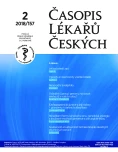Opioids and new trends in pain therapy
Authors:
Jan Lejčko
Authors‘ workplace:
Centrum pro léčbu bolesti, KARIM LF UK a FN Plzeň
Published in:
Čas. Lék. čes. 2018; 157: 67-73
Category:
Review Article
Overview
Opioids are well known for their ability to reduce the perception of pain without a loss of consciousness. However, the influence of opioids on organism is very complex. Clinical pharmacology of currently available opioid analgesics is determined by three major factors - their opioid receptor properties, pharmacokinetic properties and genetic polymorphism in the opiate receptor and cytochrome P450 isoform.
In acute severe pain are opioids very efficient. Long-term experience with opioid analgesia in patients with cancer pain has shown high favorable risk/benefit ratio. However, the treatment with opioids has its issues. Life expectancy of chronic pain patients is temporarily unlimited and for that reason the time horizon of opioid therapy is unlimited as well. In comparison with cancer pain opioid responsiveness to chronic non-cancer pain is somewhat different. Clinical experience has shown that exceeding of medium-sized doses of opioids in the treatment of chronic non-cancer pain does not lead to further improvement of analgesia, but only increases degree of physical dependency and tolerance.
The most important step is to choose the right patient. Subsequently, the success of opioid therapy depends on a careful search of balance between pain, opioid dosage and analgesia with emphasis on individualization and attention to the prevention and management of side effects.
Keywords:
opioids, opioid receptor, opioid responsiveness, physical dependency, tolerance
Sources
1. Maher TJ, Chaiyakul P. Opioids (Bench). In: Smith HS (ed.). Drugs for pain. Hanley & Belfus, Philadelphia, 2003 : 83–96. 2. Marvizon JC, Ma YY, Charles AC et al. Pharmacology of the opioid system. In: Beaulieu P, Lussier D, Porreca F, Dickenson AH (eds.). Pharmacology of Pain. IASP Press, Seattle, 2010 : 87–110. 3. Gourlay GK. Clinical pharmacology of opioids in the treatment of pain. Pain, 2002 – An Updated Review. IASP Press, Seattle, 2002 : 381–394. 4. Kršiak M, Lejčko J, Doležal T. Opioidní analgetika. In: Rokyta R, Kršiak M, Kozák J (eds.): Bolest. Tigis, Praha, 2012 : 129–145. 5. Portenoy RK. Opioid therapy for chronic nonmalignant pain: a review of the critical issues. J Pain Symptom Manage 1996; 11 : 203–217. 6. Burness CB, Keating GM. Oxycodone/naloxone prolonged-release. A review of its use in the management of chronic pain while counteracting opioid-induced constipation. Drugs 2014; 74 : 353–375. 7. Benyamin R, Trescot AM, Datta S et al. Opioid complications and side effects. Pain Physician 2008; 11(2 Suppl.): S105–S120. 8. Jovey RD. Pain, opioids and addiction – the neurobiological roots. Pain 1999 – An Updated Review. IASP Press, Seattle, 1999 : 111–114. 9. Lejčko J. Chronická bolest, opioidy a závislost – jdeme správným směrem? Bolest, 2015; 18 : 186–193. 10. Lejčko J. Dlouhodobá léčba opioidy u chronické nenádorové bolesti. Bolest 2003; 3 : 147–153. 11. Chou R, Fanciullo GJ, Fine PG et al. Clinical guidelines for the use of chronic opioid therapy in chronic noncancer pain. J Pain 2009; 10 : 113–130. 12. Kolektiv autorů. Metodické pokyny pro farmakoterapii bolesti. Bolest 2016; 19(Suppl. 1).
Labels
Addictology Allergology and clinical immunology Angiology Audiology Clinical biochemistry Dermatology & STDs Paediatric gastroenterology Paediatric surgery Paediatric cardiology Paediatric neurology Paediatric ENT Paediatric psychiatry Paediatric rheumatology Diabetology Pharmacy Vascular surgery Pain management Dental HygienistArticle was published in
Journal of Czech Physicians

- Advances in the Treatment of Myasthenia Gravis on the Horizon
- Metamizole vs. Tramadol in Postoperative Analgesia
- What Effect Can Be Expected from Limosilactobacillus reuteri in Mucositis and Peri-Implantitis?
- The Importance of Limosilactobacillus reuteri in Administration to Diabetics with Gingivitis
- The Importance of Hydration in Wound Healing
Most read in this issue
- Non-opioid analgesics
- Pathophysiology of pain and its clinical application
- Opioids and new trends in pain therapy
- Back pain treatment
